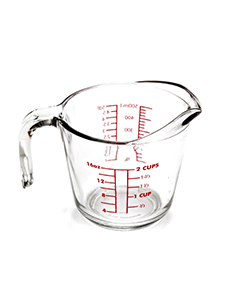Weigh & Measure: Keys to a Perfect Cup of Tea

It's a truism that the best tea leaves make the best cup.
And yet ... sometimes we've used the best tea and, well, the cup is a disappointment. Too weak. Too strong. Just not that perfection we yearn for, and deserve. What's a tea lover to do?
Weigh the tea and measure the water.
These two simple acts will go a long way to providing you with nectar in your cup.
For a professional baker, weighing and measuring are critical to successful scones and cakes and other delectable desserts. This concept began before recipes were written and many of the recipes remain and work. The classic example is the pound cake, made of a series of weighed ingredients: a pound of butter, pound of sugar, a pound of flour, a dozen eggs, and the classic cake recipe began.
Weighing the loose leaves and measuring the water for a tea lover can generate your own voilá moment.
The first thing to understand is the liquid capacity of your cup.
Your beloved teacups can hold 5 to 8 ounces and your favorite mugs can hold 8 to 12 ounces. These wildly different measurements for the capacity of a cup or mug vividly demonstrate why a teaspoon of tea in a delicate teacup tastes different from a teaspoon of tea in a 12 ounce mug.
To match tea to water capacity, fill a glass measuring cup to the 8-ounce level with tap water. (We're just measuring and discarding here, not brewing, so spring water is not necessary.)
Pour the 8 ounces of water from the measuring cup into the cup or mug you'd like to use for tea. If your teacup holds 6 ounces, you'll know that it is perfect for the industry standard of weight, 2 1/4 grams or 1 measuring teaspoon of tea leaves.
If your cup holds 8 ounces of water, you now know to amp the amount of tea up to 2 3/4 grams or 1 heaping teaspoon of tea leaves.
And, for those mugs that hold 10 to 12 ounces of liquid, 4 to 4 1/2 grams or 1 to 1 1/2 heaping tablespoons of tea should make for an excellent brew.
To measure tea accurately and precisely, nothing works better than a small food scale. Yes, your measuring spoons are fine, but the precision of a scale is so dynamic that measuring your tea with it will definitely improve your tea experience. Besides, it's fun! (Scales are available at any fine culinary shops.)
To test your scale, put a small clean piece of paper on it to prevent tea leaves from possibly clogging up the instrument.
Add a measuring teaspoon of tea onto the paper and weigh. Add to or remove tea accordingly to match the weight necessary for the type of tea you're using.
Remember that the style and texture of the tea can make a big difference in how much volume will fill a teaspoon. For example, only a level teaspoon of sencha leaves is needed to make a great cup of fresh green tea, however, it takes a heaping 1 1/2 tablespoons of large silver needle leaves to make the same quantity of tea.
The size of the original leaves or buds vary greatly. Small leaves and buds weigh more than large leaves so you need fewer small leaves to match than large leaves to match the same weight suggestion.
Measuring and weighing too challenging? Not to worry. A measuring teaspoon of such classics as Japanese greens, Indian blacks like Assam or Darjeeling, or a Ceylon or Keemun should work well, and a heaping tablespoon of oolong or silver needle leaves will be fine.
And, if you choose to drink the same two or three teas, you will indeed become familiar with the quantity of leaves required and certainly be able to "pinch" the right amount into your waiting infuser or cup.
Please DO measure the liquid capacity of your cup and adjust accordingly. You only need to measure your favorite cup or mug once to to ensure the right quantity of water for each subsequent cup of tea.
The final, critical, elements in tea-making are water temperature and time.
Follow your tea vendor's suggestion for the first cup. The vendor has spent a lot of time brewing and tasting to figure out how much tea and time are necessary to bring out the best of each tea's flavor profile.
When in doubt, brew for less time, and then taste. Continue to brew, then taste again. Do this until the tea is to your satisfaction. Remember, your palate is your optimum guide, so adjust steeping time to your satisfaction.
Vendor suggestions for what temperature is best for which tea should also be followed and then improvised to your own palate. In general, lower temperatures are suitable for whites and greens, hotter temperatures for blacks, boiling for pu-erhs. Oolongs should be brewed with temperatures in-between greens and blacks. To eliminate temperature guessing, try our utiliTEA tea kettle.
Enjoy!
NOTE:
Conversion of ounces to grams:
0.0793664143866 ounces to 2.25 gramsConversion of teaspoons to grams:
About 1/2 teaspoon (0.45648930454572 teaspoon) to 2.25 grams